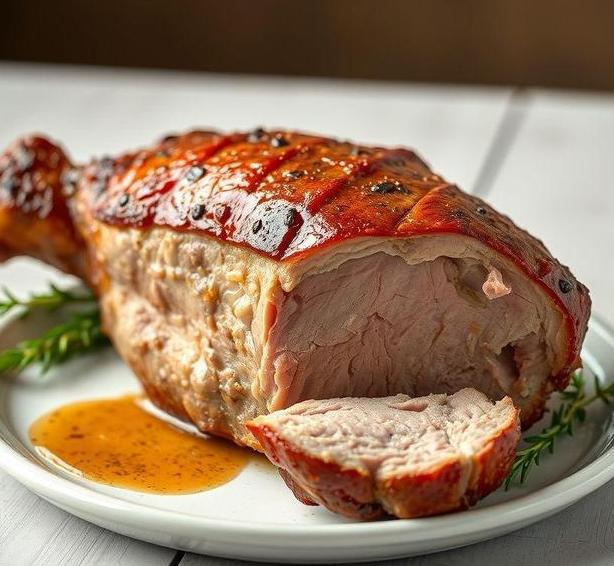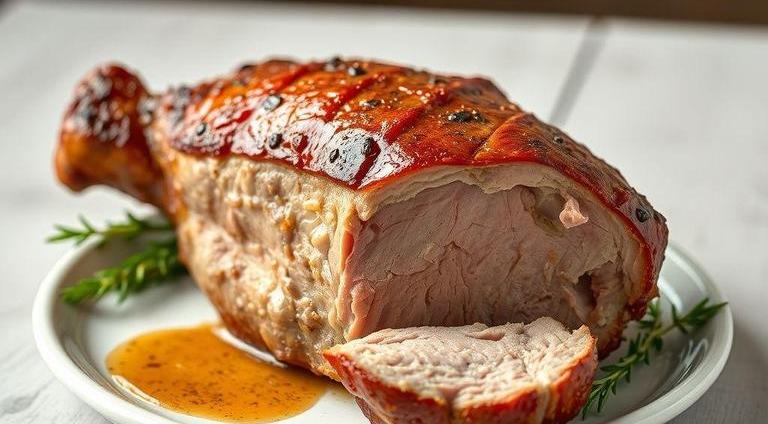Pork roast is a delicious, hearty dish that often finds its way to the table during special occasions or as a family favorite for Sunday dinners. Whether it’s a tender slow-roasted shoulder, a juicy loin, or a flavorful rib roast, pork can be a versatile and flavorful protein. But like any meat, pork roast has a limited shelf life. While it’s easy to cook a big roast, it’s just as important to understand how to handle it properly to ensure safety and maximize freshness.
Improper storage or leaving pork roast out for too long can lead to spoilage, which can result in unpleasant (and potentially dangerous) consequences. So, let’s dive deep into all things related to the shelf life of pork roast, how to spot signs of spoilage, and what steps you can take to ensure your roast stays as fresh as possible.
Can Pork Roast Go Bad?
Yes, pork roast can definitely go bad, just like any other cut of meat. Meat is perishable, meaning it can spoil and become unsafe to eat if not handled, stored, or cooked properly. The risk increases when pork roast is left in the wrong conditions for too long or is not kept at the right temperature.
When pork roast starts to go bad, harmful bacteria and pathogens, such as Salmonella and E. coli, can multiply rapidly, leading to foodborne illnesses. Spoiled meat may also lose its flavor and texture, making it unappetizing and unsafe to consume.
Shelf Life For Pork Roast

The shelf life of pork roast depends on several factors, including whether it’s cooked or raw, how it’s stored, and its condition when purchased. Here’s a breakdown of the typical shelf life of pork roast:
-
Raw Pork Roast
- In the fridge: Generally, raw pork roast will stay good for about 3 to 5 days in the fridge at 40°F (4°C) or below.
- In the freezer: If you need to store it for longer, raw pork roast can last for 6 to 12 months in the freezer, but it’s best used within 4 to 6 months for optimal taste and texture.
-
Cooked Pork Roast
- In the fridge: Once cooked, pork roast will last around 3 to 4 days in the refrigerator. The flavors and moisture may degrade over time, so it’s always best to eat it sooner rather than later.
- In the freezer: Cooked pork roast freezes well for 2 to 3 months. However, its texture may suffer after longer storage periods.
The key to preserving pork roast is proper storage. If you’re ever unsure whether it’s still good, it’s always better to err on the side of caution.
Common Signs Of Spoilage
Knowing how to spot signs of spoilage in pork roast can save you from eating unsafe food. Here are the key indicators that your pork roast may have gone bad:
-
Off Or Sour Smell
One of the most obvious signs that pork has spoiled is a strong, unpleasant odor. Fresh pork should have a mild, slightly sweet smell. If it’s giving off a sour, rancid, or putrid odor, it’s time to toss it.
-
Discoloration
Fresh pork roast is typically light pink with a hint of white fat. If you notice that the meat has turned gray, brown, or even greenish, it’s a sign that the pork is spoiled. Slight discoloration near the surface is common, but if it’s throughout the meat, discard it.
-
Slimy Texture
A slimy or sticky texture is another red flag. Fresh pork should feel firm and moist, but it should not be slippery or sticky to the touch. If it feels slimy, bacteria may have started to break down the meat.
-
Mold
Mold growth is a clear sign that pork roast has gone bad. This can appear as fuzzy, green, blue, or white spots on the surface. If you see mold, don’t just cut it off-discard the entire roast.
-
Changes In Color Or Texture After Cooking
Sometimes, pork roast can look perfectly fine when you put it in the fridge, but if it has an unusual color or texture after reheating, it could be a sign of spoilage. The meat may become overly dry, mushy, or rubbery, signaling a breakdown of its quality.
How To Store Pork Roast?

Proper storage is key to maintaining the freshness and safety of your pork roast. Here are some essential storage tips:
Refrigeration
- Storage Containers: Always store raw pork roast in a sealed container or wrap it tightly in plastic wrap or foil to prevent contamination from other foods.
- Temperature: Make sure your fridge is set at or below 40°F (4°C) to slow the growth of harmful bacteria.
Freezing
- Wrapping: To freeze pork roast, wrap it tightly in heavy-duty plastic wrap or freezer paper, followed by a layer of aluminum foil. You can also place it in a freezer-safe zip-top bag to prevent freezer burn.
- Labeling: It’s helpful to label your pork roast with the date so you can track how long it’s been in the freezer.
- Freezer Storage Time: While pork roast can last in the freezer for months, for the best texture, aim to consume it within 4 to 6 months.
Leftovers
- After cooking, store leftover pork roast in an airtight container in the fridge. For added protection against moisture loss, wrap the roast in foil or wax paper before storing it in a container.
- Be sure to refrigerate cooked pork roast within 2 hours of cooking to prevent bacteria growth.
Expert Tips
To ensure your pork roast stays as fresh as possible and that you’re minimizing any risk of spoilage, here are some expert tips:
- Use a Meat Thermometer: If you’re cooking a large roast, using a meat thermometer is essential. Pork should be cooked to an internal temperature of at least 145°F (63°C) and allowed to rest for three minutes before serving.
- Cool Down Quickly: If you have leftovers, make sure to cool them down to room temperature quickly (within 2 hours) before refrigerating. This can help prevent bacterial growth.
- Vacuum Sealing: If you’re planning on storing pork roast for an extended period in the freezer, consider vacuum-sealing it. This removes air and helps prevent freezer burn, extending its shelf life.
- Don’t Refreeze: If you’ve already thawed pork roast, avoid refreezing it. Once meat has been thawed, it should be cooked and consumed within a few days to ensure its safety.
FAQs
Can Cooked Pork Roast Go Bad?
Yes, cooked pork roast can go bad if not stored properly. It should be refrigerated within two hours of cooking, and ideally consumed within 3-4 days. If left at room temperature for more than 2 hours, harmful bacteria can grow, making it unsafe to eat.
How Long Does A Cooked Pork Roast Last In The Refrigerator?
Cooked pork roast can last up to 3-4 days in the refrigerator when stored in an airtight container. After this time, it may start to spoil and should be discarded.
Can You Freeze A Cooked Pork Roast To Make It Last Longer?
Yes, you can freeze cooked pork roast. It should be wrapped tightly in plastic wrap or aluminum foil, or stored in an airtight container. Frozen pork roast will maintain its best quality for up to 2-3 months, though it may last longer if stored properly.
How Can You Tell If A Pork Roast Has Gone Bad?
Signs that a pork roast has gone bad include a sour or rancid odor, slimy texture, discoloration (gray or greenish hues), and mold growth. If any of these signs are present, the pork roast should be discarded.
Can Raw Pork Roast Go Bad?
Yes, raw pork roast can go bad if not stored correctly. It should be kept in the refrigerator and used within 3-5 days of purchase. If left at room temperature for too long, bacteria like Salmonella or E. coli can multiply, making it unsafe to consume.
How Long Can A Raw Pork Roast Last In The Freezer?
A raw pork roast can last up to 4-6 months in the freezer without losing quality. After this period, it may still be safe to eat but the texture and flavor might deteriorate.
Can Pork Roast Spoil If Left Out Overnight?
Yes, pork roast can spoil if left out overnight. The USDA advises that perishable food items like pork roast should not be left out at room temperature for more than two hours, as bacteria can multiply rapidly, making the food unsafe.
What Should You Do If You Accidentally Left Pork Roast Out For Several Hours?
If pork roast has been left out for more than two hours, it is safest to discard it. Even if it looks fine, harmful bacteria might be present, which can cause foodborne illnesses.
Can Reheating Pork Roast Kill Bacteria?
Reheating pork roast can kill some bacteria, but it may not eliminate all harmful pathogens, especially if the roast was left out too long. The best practice is to refrigerate or freeze pork roast within two hours of cooking and to reheat it thoroughly when you’re ready to eat it.
What Is The Best Way To Store Pork Roast To Prevent It From Going Bad?
To prevent pork roast from going bad, it should be stored in an airtight container in the refrigerator. For longer storage, it can be frozen. Always make sure the roast is properly cooled before storing it to avoid moisture buildup, which can promote bacterial growth.